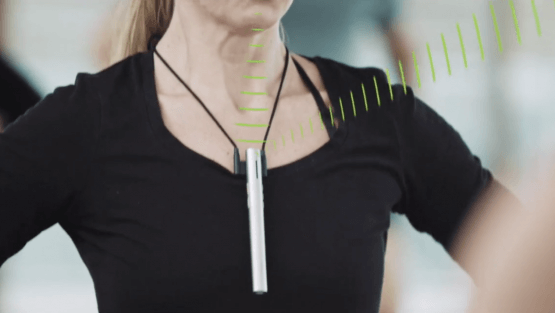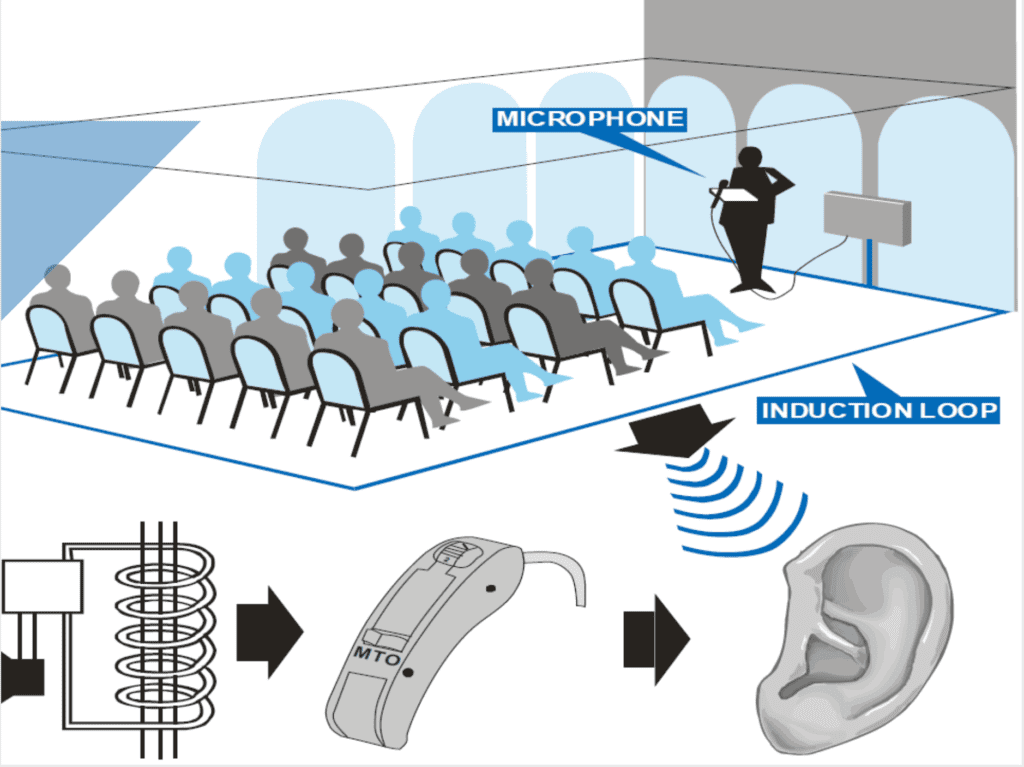BLOG
Home » An Induction Loop System: What Is It, And What Are My Options?

An Induction Loop System: What Is It, And What Are My Options?
Do you have trouble hearing the TV or music from your speakers? Maybe you want to enjoy an occasional trip to the cinema – but often find it hard to hear what’s happening on screen. Thankfully, help is at hand for millions of people who want to ‘tune into’ their favourite entertainment. An induction loop system may be something you’ve heard of before – and if you already use hearing aids, you may already know a little bit about the technology!
What is an induction loop system?
An induction loop system enables hearing aid users to hear sound emitting from TVs, speakers and public audio more clearly. It works through the simple science of magnetic fields!
Traditionally, an induction loop system will, first of all, include a hearing aid – one that has a T switch or an MT switch. This type of hearing aid normally fits over your ear, and can tune to electromagnetic fields. The T or MT switch will commonly help people to hear their home or mobile phones more clearly.
Induction loop systems, however, go one step further. Using this switch technology, a loop is fitted, along with an amplifier, to connect to an audio source. Essentially, the ‘loop’ in question is actually a simple length of cable!
An induction loop will effectively amplify sound by expanding the reach of a magnetic field. Therefore, a compatible hearing aid can then connect to a larger magnetic field with greater ease, thus being able to hear what’s projected more clearly.
Where can induction loops be installed?
 Traditionally, you may have noticed signs around public buildings and spaces confirming that hearing aid users can tune into loop systems. You may recognise a simple ‘ear’ symbol with either the letters T or MT to establish that you can switch your hearing aids to tune in.
Traditionally, you may have noticed signs around public buildings and spaces confirming that hearing aid users can tune into loop systems. You may recognise a simple ‘ear’ symbol with either the letters T or MT to establish that you can switch your hearing aids to tune in.
Induction loops can be found in doctor’s offices, dentist’s surgeries, cinemas, stadiums, even some churches, cathedrals and venues. Ultimately, if there is likely to be an emphasis on sound – or if it is important that you hear what’s taking place – there is likely to be an induction loop in place.
However, you can also set up induction loop systems at home! These can be easy to ‘plug and play’ with minimal instructions – therefore, helping you to listen to and enjoy your regular TV programming and choice of music in crisper, clearer audio!
The huge benefit to using an induction loop lies in the fact that the hearing aid user never has to plug into any extra equipment. If your hearing aid already has that all-important T or MT switch, then all you need to do is activate it – and you should be able to pick up a whole new world of sound.
What are personal induction loops?
While public and home induction loop systems have been popular for many years now, more and more people are getting into personal induction loops, too. As you may imagine, these loop services allow you to connect to a portable amplifier no matter where you are – simple for you to move from one room to another, or even to take outside.
The huge benefit to personal induction loops lies in the fact you don’t have to rely on public spaces or venues to have loops installed. What’s more, it means you can also expect the same quality of hearing through all that you do. Crisper, clearer audio doesn’t have to start and end with entertainment.
For example, if you need to head to an important meeting, or need to talk to someone face to face at your bank or doctor’s surgery, you can simply switch on your personal loop, activate your T or MT switch, and enjoy a natural standard of hearing like never before.
How does an induction loop system help people?
 Induction loop systems help to connect hard-of-hearing people to public buildings and spaces without the need for awkward connectivity or extensive cabling. Those people wearing applicable hearing aids can simply tune into an induction loop system and expect natural quality audio.
Induction loop systems help to connect hard-of-hearing people to public buildings and spaces without the need for awkward connectivity or extensive cabling. Those people wearing applicable hearing aids can simply tune into an induction loop system and expect natural quality audio.
This means that they can enjoy time with their family and friends more, and if they need to attend meetings or important conferences, they can do so without having to worry about missing any important details. The same applies when going to enjoy public entertainment – whether at the cinema, the theatre, a music venue or otherwise.
The science behind induction loop systems is incredible. Rather than expecting the user to strain their hearing to better focus on what’s being said or played, an induction loop system will instead amplify or extend the magnetic field the noise is making. This doesn’t mean increasing the volume, or making things awkward for non-hearing aid users, either!
Where do I start with induction loop systems?
A great place to start is to consider using a hearing aid or hearing aids with T or MT switches. Providing you have this technology in place, you can connect to public induction loops without the need for any existing hardware.
However, if you want to be able to listen to your TV, radio or speakers a little clearer at home, you can invest in simple induction loop kits that are easy to plug in and activate when you need them.
Beyond this, personal induction loop systems will help you to hear the world around you wherever you go. This simply requires you to have a small, convenient system to hand – and, as with other induction loop standards, there’s no need for you to have to plug directly into any public terminals or hardware.
Induction loop systems have helped to revolutionise the way that people hear. Here at Hearing Loop, we’re proud to offer a fantastic range of induction loop technologies to ensure you can start to hear the people and entertainment you love without having to strain – and certainly without feeling embarrassed.
Take a closer look at our catalogue of products online, and do reach out to our friendly team if you have any queries or concerns!
Categories
- Assisted Living (3)
- Communication (4)
- Compliance (2)
- Cordless Telephones (3)
- Design Survey (1)
- Features & Benefits (1)
- Features & Benefits (1)
- General Hearing (4)
- Hearing Loop Systems (14)
- Hearing Loop Uses (4)
- Hearing Loops (29)
- Installation & Commissioning (3)
- Installation & Commissioning (1)
- Portable Hearing Loop (3)
- Portable Hearing Loops (15)
- Service & Maintenance (2)
- Service & Maintenance (1)
- Uncategorized (2)
Recent Posts
- 10 Remarkable Benefits of Using the PL1/K1 Portable Hearing Loop System
- The Ultimate Guide to Phonak Roger ON: How It Works and Who It’s For
- The PL1/K1 Portable Hearing Loop: A Game-Changer for Midwives and Community Healthcare Providers
- Future Proofing Your Portable Hearing Loop System Investment
- What is Hearing Loop Technology?

